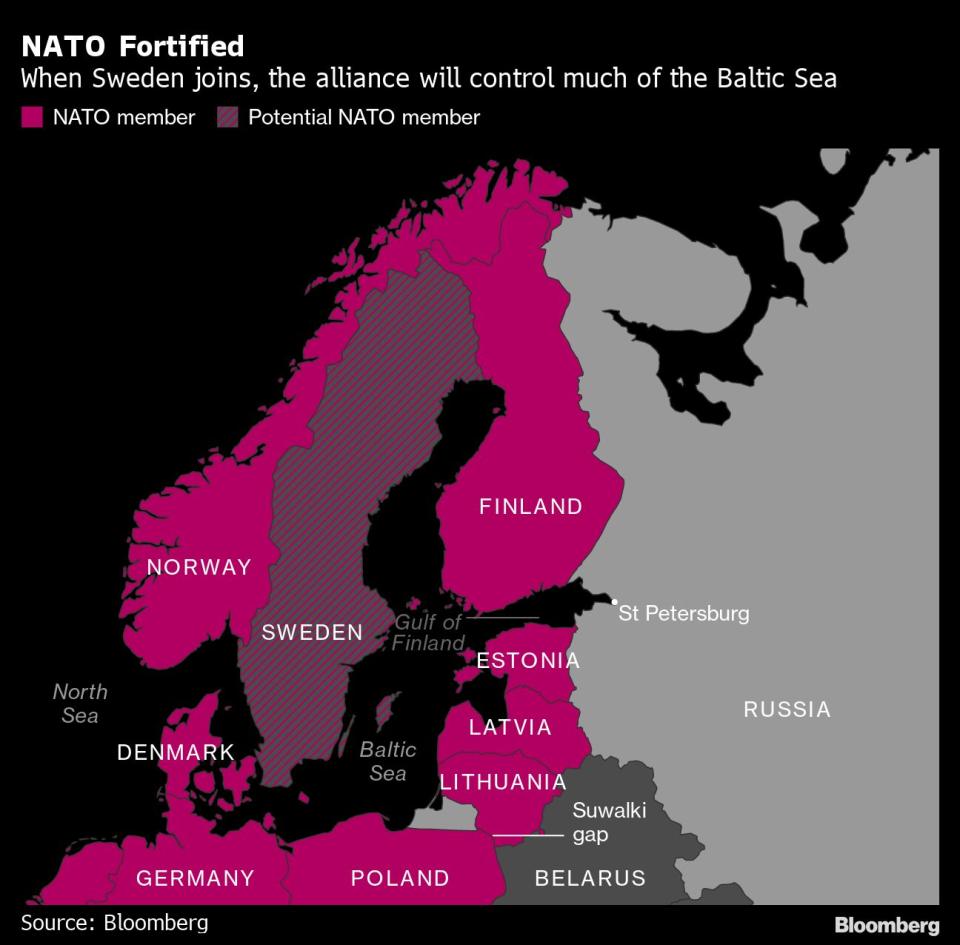Finland Joins NATO as Defense Alliance Expands Northward
(Bloomberg) -- Finland became the 31st member of NATO, completing a tumultuous process of accession sparked by Russia’s invasion of Ukraine that upended the European security landscape.
Most Read from Bloomberg
UBS Chairman’s Top-Secret Prep Paid Off in Credit Suisse Moment
China’s Yuan Replaces Dollar as Most Traded Currency in Russia
Bernard Arnault’s Fortune Soars Past $200 Billion for First Time
In a bittersweet moment, Finland gained Article 5 security guarantees and deterrence, but was forced to leave its close neighbor Sweden behind on the doorstep of the North Atlantic Treaty Organization.
Foreign Minister Pekka Haavisto handed Finland’s accession document to US Secretary of State Antony Blinken in Brussels on Tuesday, marking its formal entry into the alliance’s fold. NATO foreign ministers will celebrate the accession with a flag-raising ceremony later in the day.
“We can now declare that Finland is the 31st member of the North Atlantic Treaty,” Blinken said.
The accession of just one of the two Nordic countries will make the alliance’s northern enlargement incomplete as NATO seeks to boost its presence in the Arctic, with the High North area’s significance increasing, as well as to gain more clout in the Baltic Sea.
“Finland becomes safer by belonging to an an alliance where we guarantee the security of all allies,” NATO Secretary General Jens Stoltenberg told reporters. “By becoming a full-fledged member we are removing the room for miscalculation in Moscow about NATO’s readiness to protect Finland and that makes Finland safer and NATO stronger.”
Finland’s addition will bring NATO more than 1,300 kilometers (800 miles) of border with Russia, doubling its eastern flank, and a nation that’s already prepared to defend itself in case of an all-out war. For the Finnish military, membership is a culmination of years of ever-closer cooperation, with gear used by the defense forces already compatible with that of the alliance.
The push to join NATO was triggered by Russia’s attack on a neighboring country, Ukraine, leading to a U-turn in public opinion on membership as Finns concluded that could also happen to them.
As a full member, Finland can benefit from Article 5 mutual defense commitments — meaning allies are bound to come to its aid if it’s under attack — and the Nordic country will have to be ready to defend other allies, too.
‘Act of Peace’
When announcing the decision to file an application in May 2022, Prime Minister Sanna Marin called it “an act of peace so that there would never again be war in Finland.”
And while Russia poses a limited threat as it is currently bogged down in its war in Ukraine, allies don’t want to underestimate Moscow’s ability to reconstitute its forces after the war.
The Finnish entry is set to enable the bloc to further secure the area around the Baltic Sea in defense of its members Estonia, Latvia and Lithuania, which are often seen as potential targets of Russian aggression. It also brings another Arctic nation into the fold of the alliance, one whose military is trained for cold weather — an important asset at a time when the High North is gaining in strategic importance in light of the increased presence of Russia and China.
The Kremlin branded Finland’s accession to NATO as yet another “aggravation” of the standoff between Russia and the West, and said it plans to carefully monitor the actions of NATO in Finland and respond accordingly.
‘Countermeasures’
“NATO expansion is an encroachment on our security and the interests of the Russian Federation. That is how we perceive it. We will take countermeasures,” Kremlin spokesman Dmitry Peskov said according to the state news service Tass.
For NATO, Finland’s ratification marks one of the swiftest accessions in history, sealing membership in less than a year since the two Nordic countries applied last May. North Macedonia was last to join the alliance, a process that took two decades. Along with Sweden other countries, including Ukraine and Georgia, are also left waiting at NATO’s door.
As its first act as NATO member, Finland submitted the ratification of Sweden’s membership to Blinken.
Having won independence in 1917 after more than 100 years as a Grand Duchy of the Russian Empire, Finns fought two wars with the Soviet Union, ceding parts of their territory in 1944. Finland then tiptoed through an era of neutrality during the Cold War — by necessity, not by choice — cowering to Moscow while retaining independence in a policy that came to be known as Finlandization.
After the collapse of the Soviet Union, the Nordic country immediately sought entry into the European fold in Sweden’s wake, with the two joining the European Union in 1995. Until last year, Finnish policy makers almost never identified Russia — at least publicly — as the primary military threat.
Geared for survival, the country of 5.5 million people has always remained on alert. It’s able to deploy 280,000 troops in wartime from a trained reserve just short of a million, thanks to a conscription-based system where most men and some women undergo military training lasting from six months to a year.
Finland’s military equipment boasts a large number of artillery and tanks. It’s also awaiting delivery of 64 Lockheed Martin Corp. F-35A multi-role fighter jets to replace its aging fleet of F/A-18 Hornets.
--With assistance from Thomas Hall and Courtney McBride.
(Updates with Finland’s formal entry, Russian response)
Most Read from Bloomberg Businessweek
©2023 Bloomberg L.P.



